
The prewalk pint

The Black Friar -- see him in the upper right thar?

Now that's house on haunted hill!!
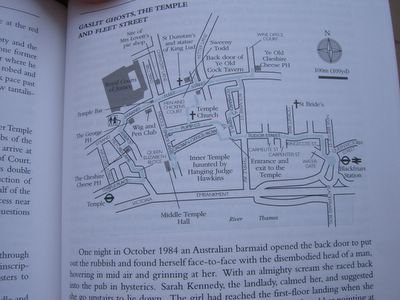
The route

The first reading of the 12th Night happened here....but that wasn't the focus of the walk...a skeleton was found here sometime later and no one knows who can claim it...but the claimant does walk around

We were at the Temple Church and here's waht's to be said about this site: The Temple gets its name from the Knights Templar, the monastic military order founded in 1118 with the avowed intent of protecting pilgrims on the road to Jerusalem. This was their London citadel and in 1185 they built their Round Church, which was modelled on the Holy Sepulchre in Jerusalem, and which still survives today. The Templars were well-connected and soon became influential in the politics of the age. They quickly attracted grants of land and money as the younger sons of noble families flocked to enrol in their ranks, and by the 13th century they were one of the most powerful monastic orders in Christendom. In England the Master of the temple was frequently called to sit in the King�s Parliament and successive monarchs, King John included, frequently stayed at the Templars London base, and the Master of the order was by the King�s side at the signing of Magna Carta. By the early years of the 14th century the Templars were the most powerful monastic Orders in Europe and were answerable only to the Pope himself.
But their success attracted the jealousy and greed of many other Orders and eventually that of the nobility and monarchs of Europe as well. In 1306 Philippe 1V of France had become determined to rid his territories of the Knight Templars. At dawn on Friday October 13th 1307 the King made his move, and with the backing of the Pope, Clement V, all the Knights Templars in France were simultaneously arrested by Philippes agents. Under torture, some Templars "admitted" to all manner of blasphemous and indecent acts. Many of their number were burnt at the stake and eventually in 1312 the order of the Knights Templar was officially dissolved throughout Europe.
There are many conspiracy theories concerning the real reason for dismantling of the order, and some of them go far beyond the simple and obvious motive that Philippe simply wanted to get his hands on their lands. Several modern day fringe researchers have claimed that the order stored secret knowledge, linking them to the lost teachings and relics of Christ, including the Holy Grail.
But in London, their Round Church still stands as a proud testimony to these soldiers of Christ. In 1324 the Templars London estate was given to the Knights Hospitallers of St John, and some of the monastery buildings were rented to law students for accommodation. The connection with the law flourished and it is lawyers who today worship in the church.
Despite its extensities renovation following bomb damage in the Second World War, the Temple Church is still a very special and atmospheric place. The first thing that strikes you when you enter are the effigies of knights that lie peacefully recumbent on the floor within. The hustle and bustle of the world outside seems centuries away as you stand gazing down upon these long ago members of the order, and such is the power of the building that some people claim that this building is one of the most psychically charged structures in the whole of London.
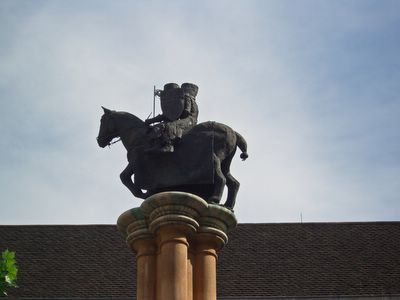
All that remains

Do I spy...

St Pauls...now that's something I am sure Edward Rutherford has written about (re: Pillars of the Earth and Sarum)

Ye Olde Cheshire Cheese is one of the few pubs in London that can justify the Ye Olde in its name. It was well known in the 17th century and many pubs have previously occupied this site, one of them the Horn Tavern, is recorded in 1538. The earliest incarnation was a guest house belonging to a 13th century Carmelite Monastery, the pub's vaulted cellars are thought to belong to that building. The pub was destroyed in the Great Fire of 1666 and rebuilt the following year.
Approached through a narrow alleyway (Wine Office Court) the Cheese beckons you into a bygone world. By the entrance a board lists the reigns of the 15 monarchs through which this grand old pub has survived. The dark wooden interior is an enchanting warren of narrow corridors and staircases, leading to numerous bars and dining rooms. There are so many, even regulars get confused.
On the ground floor are two rooms. The smaller is a very dark panelled bar with a large open fireplace and high mantle. Above this is a portrait of William Simpson, who started as a waiter in 1829, which was to be passed down to future landlords.
The Chop Room across the corridor is usually reserved for diners. Here high backed settles have been arranged back to back to create small booths. A portrait of one of the Cheese's most famous patrons, Dr. Samuel Johnson (his house is around the corner) hangs on a far wall, and his chair set upon a shelf. A copy of Johnson's dictionary should be nearby. Another painting of Johnson and his biographer, Boswell, was found in a cellar relatively recently and restored.
In the main stairwell increasingly narrow steps lead up to a couple of atmospheric dining rooms and to private quarters. Unfortunately these rooms are often closed, which is a shame as they give a feel to the rambling nature of this wonderful old building.
Negotiating the narrow and awkward steps down to the cellar bars is rewarded with the discovery of the vaults, a fascinating series of tiny, honey coloured stone rooms. These vaults were part of the original guest house's chapel. The steps continue into the cellar proper, where a further bar and dining area can be found.
Volumes of visitors books were kept and signatories include Ambassadors, Prime Ministers and Royalty. Unfortunately these records began after the likes of Dr. Johnson, James Boswell, Voltaire, Thackeray and of course Charles Dickens (originally a Fleet St. journalist) drank here. One famous resident was a parrot who's mimicry entertained customers for 40 years, its death was announced on the BBC and obituaries appeared in newspapers all over the world.
Each generation that passes through the Cheese adds to its rich history. Note: that darn parrot could cuss in 9 languages!!

Sweeney Todd, (also spelt Sweeny) the demon barber of Fleet Street had his shop at number 186 Fleet Street, which is now the Dundee Courier building with a Kwick copier shop. On this site he is believed to have robbed and murdered over 150 customers, thereby making him the number one serial killer in British history. Born on 16 October 1756, at number 85 Brick Lane, London, E1. Todd's mother was a silk-winder and his father a silk weaver, working for the French Huguenots in nearby Spitalfields. In 1770, aged only 14 years, Sweeney Todd was sentenced to a five year term in Newgate Prison for theft. While in prison he met up with an old barber named Plummer, who was serving ten years for embezzlement, he taught Sweeney how to cut hair and shave, and how to pick pockets of the customers, Sweeney was keen and soon became Plummer's apprentice lathering-up and shaving some of the prisoners who could afford their services. After his release in 1785, with a few pounds he had stolen at work in the goal, and the little knowledge of haircuts he gained, Sweeney Todd opened his Barber Shop at 186 Fleet Street, next door to St Dunstan's Church, just a few blocks away from the Royal Courts of Justice, and next to Chicken and Hen Court by the corner of Fetter Lane. Going west from Chancery Lane opposite the Temple Bar is Bell Yard, a narrow alleyway where Mrs Lovett a girl friend of Sweeney�s had her pie shop


Dang! That was the freakiest thing -- this door that was down there, under the sewer grill, and it opened up to a sewer tunnel

Dates from 1185. Has a bust to William Tyndale who preached here. John Donne was also rector here. And Izaac Walton (of fishing fame) worshiped here. Samuel Pepys used the church as a place to pick up pretty serving-girls - but had little luck as his diary laments. The clock has two figures, of Gog and Magog who mark the time. Just inside the doorway are old statues of King Lud and his two sons. Apparently Gog and Magog (how's that as the names of my progeny?) are 10-15 minutes late...we waited and I got impatient and was watching traffic when I hear dull gong and well, THAT'S IT!! How *very* anticlimactic....phooey

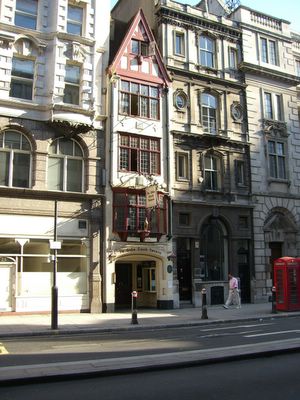
I loved how this building was squished up between 2 others...couldn't have been more than a few paces across...it reminded me something out of Harry Potter y'know?
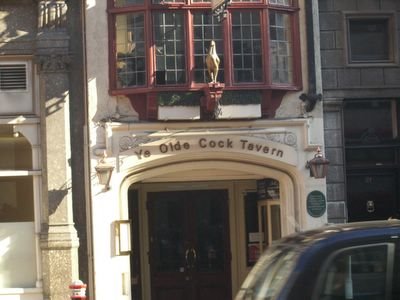

Until the 18th century there were eight such gates, of which only one survives; the others exist in name only (Cripplegate, Ludgate, Bishopsgate, Moorgate, and so on). The surviving one is Temple Bar Memorial, a bronze griffin on the Strand opposite the Royal Courts of Justice, at which the sovereign has to ask permission to enter the City from the Lord Mayor. (The original gate has been restored and returned further into the City, opposite St. Paul's Cathedral.)
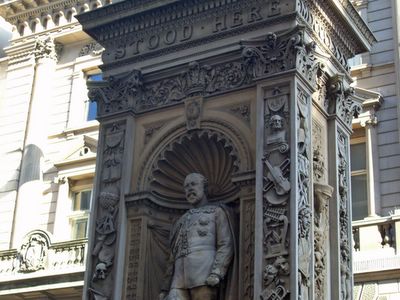
Details...hahaha, in a moment of vanity, would love to see something like that with the word "Zaphod Stood Here"

I tried (with no luck) to get the griffin column to line up with the buikdings and get the griffin perched on the rood...but in a larger print, looks like a tear (no, not the kind you get while chopping onions but the paper rip ones) in the blue sky



Well, that was that but I was going to get detergent to do laundry for the first time ( and I dont think the water taps to the machine are open becuase the clothes seem to be running around inside it but I dont see any water! The manual says I shouldn't expect to....eh??) (God I ramble!!) anyway so on the way home saw this random festival happeneing in a dead in....gotta love an area where stuff like this happens!
No comments:
Post a Comment